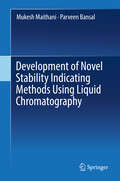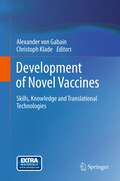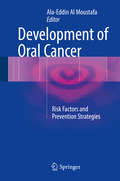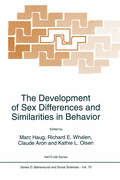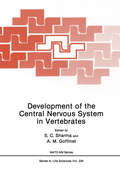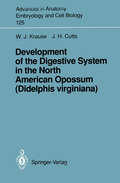- Table View
- List View
Development of Novel Stability Indicating Methods Using Liquid Chromatography
by Mukesh Maithani Parveen BansalReversed-phase high-performance liquid chromatography (RP-HPLC) has become the most widely used method for pharmaceutical analysis, as it ensures accuracy, specificity and reproducibility for the quantification of drugs, while avoiding interference from any of the excipients that are normally present in pharmaceutical dosage forms. This book presents a simple methodology for developing stability-indicating methods and offers a ‘how-to guide’ to creating novel stability-indicating methods using liquid chromatography. It provides the detailed information needed to devise a stability-indicating method for drug substances and drug products that comply with international regulatory guidelines. As such, it is a must-read for anyone engaged in analytical and bioanalytical chemistry: professionals at reference, test, and control laboratories; students and academics at research laboratories, and scientists working for chemical, pharmaceutical, and biotechnology companies.
Development of Novel Vaccines: Skills, Knowledge and Translational Technologies
by Alexander von Gabain and Christoph Klade“Development of novel vaccines” gives an overview of the tasks in basic research leading to the final product – the vaccine and its applications, belonging to the most complex biologics in the pharmaceutical field. Distinct from most textbooks in the vaccine arena, the current issue focuses on the translational aspect, namely, how research results can be transformed into life-saving medical interventions. Each chapter of the book deals with one important paradigm for the development of novel vaccines, along the value chain towards the final vaccine, and furthermore, with the inevitable tools required for this process. Contributions are prepared by teams of scientists, all of whom are experts in the field, most of them anchored in biomedical organizations devoted to translational culture, thereby lighting the certain topics from different views. This volume is a must read for researchers engaged in vaccine development and who really want to see their research results to become a product.
Development of Oral Cancer: Risk Factors and Prevention Strategies
by Ala-Eddin Al MoustafaThis book aims to provide the reader with a complete understanding of the development of oral cancer by explaining the role of a wide variety of implicated risk factors and identifying their gene targets and key regulators. Some of the discussed risk factors are well known, including smoking, alcohol, betel quid chewing, and oncoviruses such as high-risk human papillomaviruses and Epstein-Barr virus; however, careful attention is also paid to less widely recognized factors, such as Qat chewing and yerba Mate consumption. The book concludes by describing and evaluating the most important strategies currently available for the prevention of oral carcinogenesis in humans. In presenting the most up-todate research and knowledge on these topics, this book will serve as a valuable source of up-to-date information for oncologists, cancer scientists, and medical students.
Development of Order in the Visual System (The Cell and Developmental Biology of the Eye)
by S. Robert Hilfer Joel B. SheffieldThe eye has fascinated scientists from the earliest days of biological in vestigation. The diversity of its parts and the precision of their interaction make it a favorite model system for a variety of developmental studies. The eye is a particularly valuable experimental system not only because its tissues provide examples of fundamental processes, but also because it is a prominent and easily accessible structure at very early embryonic ages. In order to provide an open forum for investigators working on all aspects of ocular development, a series of symposia on ocular and visual devel opment was initiated in 1973. A major objective of the symposia has been to foster communication between the basic research worker and the clinical community. It is our feeling that much can be learned on both sides from this interaction. The idea for an informal meeting allowing maximum ex change of ideas originated with Dr. Leon Candeub, who supplied the nec essary driving force that made the series a reality. Each symposium has concentrated on a different aspect of ocular development. Speakers have been selected to approach related topics from different perspectives.
Development of Plant-Based Medicines: Conservation, Efficacy and Safety
by Praveen K. SaxenaThe `plant' is often the most neglected part of plant-based medicine. Throughout time, humans have searched, collected, and effectively used plants for healing. Currently, the medicinal plant-based business is flourishing at a dramatic pace and at the expense of an already declining population of plant species, many of which are on the verge of extinction. In spite of this history and popularity, the mystery of what transforms a plant into a medicinal plant persists, and there are chronic problems with ensuring the safety and efficacy of medicinal plant products. Therefore, there is a real need for a full characterization of medicinal plant species and for the development and application of novel technologies for the production of plant-based medicines. This book highlights some of the recent advances and new approaches to the development of technologies for plant-based medicines and is intended to stimulate new discussions among researchers, regulatory authorities, and pharmaceutical organizations, leading to significant advancements in the field.
Development of Quality of Life Theory and Its Instruments: The Selected Works of Alex. C. Michalos
by Alex C. MichalosThe focus of this volume is on the further development of the Quality of Life Theory and the means to measure the concept. The volume summarizes Michalos’ fundamental assumptions about the nature of quality of life or human well-being and explains in detail the two variable theory of the quality of life. It gives an update of the journal Social Indicators Research after forty years, an explanation of the role of community indicators in connecting communities, and a critical review of the much publicized Stiglitz, Sen and Fitoussi report. It deals with the multiple discrepancies theory (MDT), the empirical theory designed to provide the foundation of the pragmatic theory of value. Other concepts discussed in this volume are the stability, sensitivity, and other different features of measures of domain and life satisfaction and happiness, measures of arts-related activities and beliefs, measures of knowledge, attitudes and behaviour concerning sustainable development, and the role of quality of life in sustainable development research. The volume concludes with discussions on connections between social indicators and communities, aspects of community quality of life in Prince George, British Columbia and Jasper, Alberta, and British Columbians’ expectations and attitudes going into the third millennium.
The Development of Relational Aggression
by Sarah M. Coyne and Jamie M. OstrovResearch over the last few decades has revealed that individuals use a variety of mechanisms to hurt one another, many of which are not physical in nature. In this volume, editors Sarah M. Coyne and Jamie M. Ostrov turn their focus on relational aggression, behavior that is intended to cause harm to another individual's relationships or social standing in the group (e.g., gossiping, social exclusion, and spreading malicious rumors). Unlike physical aggression, the scars of relational aggression are more difficult to detect. However, victims (and their aggressors) may experience strong and long-lasting consequences, including reduced self-esteem, loneliness, depression, anxiety, and more. Over the past 25 years, there has been a growing body of literature on relational aggression and other non-physical forms of aggression that have focused predominantly on gender differences, development, and risk and protective factors. In this volume, the focus turns to the development of relational aggression during childhood, adolescence, and emerging adulthood. Here, Coyne, Ostrov, and their contributing authors examine a number of risk factors and socializing agents or models (e.g., parenting, peers, media, the classroom) that lead to the development of relational aggression over time. An understanding of how these behaviors develop will inform readers of important intervention strategies to curb the use of relational aggression in schools, peer groups, and in family relationships. The Development of Relational Aggression provides scholars, researchers, practitioners, students, and parents with an extensive resource that will help move the field forward in our understanding of the development of relational aggression for the future.
The Development of Relational Aggression
Research over the last few decades has revealed that individuals use a variety of mechanisms to hurt one another, many of which are not physical in nature. In this volume, editors Sarah M. Coyne and Jamie M. Ostrov turn their focus on relational aggression, behavior that is intended to cause harm to another individual's relationships or social standing in the group (e.g., gossiping, social exclusion, and spreading malicious rumors). Unlike physical aggression, the scars of relational aggression are more difficult to detect. However, victims (and their aggressors) may experience strong and long-lasting consequences, including reduced self-esteem, loneliness, depression, anxiety, and more. Over the past 25 years, there has been a growing body of literature on relational aggression and other non-physical forms of aggression that have focused predominantly on gender differences, development, and risk and protective factors. In this volume, the focus turns to the development of relational aggression during childhood, adolescence, and emerging adulthood. Here, Coyne, Ostrov, and their contributing authors examine a number of risk factors and socializing agents or models (e.g., parenting, peers, media, the classroom) that lead to the development of relational aggression over time. An understanding of how these behaviors develop will inform readers of important intervention strategies to curb the use of relational aggression in schools, peer groups, and in family relationships. The Development of Relational Aggression provides scholars, researchers, practitioners, students, and parents with an extensive resource that will help move the field forward in our understanding of the development of relational aggression for the future.
The Development of Scientific Marketing in the Twentieth Century: Research for Sales in the Pharmaceutical Industry (Studies for the Society for the Social History of Medicine)
by Jean-Paul GaudilliereThe global pharmaceutical industry is currently estimated to be worth $1 trillion. Contributors chart the rise of scientific marketing within the industry from 1920-1980. This is the first comprehensive study into pharmaceutical marketing, demonstrating that many new techniques were actually developed in Europe before being exported to America.
The Development of Scientific Marketing in the Twentieth Century: Research for Sales in the Pharmaceutical Industry (Studies for the Society for the Social History of Medicine #22)
by Jean-Paul GaudilliereThe global pharmaceutical industry is currently estimated to be worth $1 trillion. Contributors chart the rise of scientific marketing within the industry from 1920-1980. This is the first comprehensive study into pharmaceutical marketing, demonstrating that many new techniques were actually developed in Europe before being exported to America.
Development of Sensory Systems (Handbook of Sensory Physiology #9)
by C. M. Bate V. McMillan Carr P. P. Graziadei H. V. Hirsch A. Hughes D. Ingle A. G. Leventhal G. A. Monti Graziadei E. W. Rubel R. Saxod A. B. Scheibel M. E. Scheibel J. SilverThis preface is addressed to the reader who wishes to inquire into the prevailing concepts, hypotheses and theories about development of sensory systems and wants to know how they are exemplified in the following chapters. I believe that science is hypothesis and theory and that the growth and evolution of any branch of science can be measured by the degree to which its theories have been reified. By that standard, one must conc1ude that developmental neuro biologie is in its infancy. The rapid accumulation of observations which has occurred in this branch of science in the past century leads to progress only to the extent that the facts validate or falsify hypotheses. The following chapters show that we have a plethora of facts but a dearth of hypotheses. Another index of the maturity of any branch of science is its level of historical self-awareness. Because the history of any branch of science is essentially the history of ideas and of the rise and fall of theories, the level of historical awareness is related to the extent to which reification of its hypothetical constructs has advanced. It is largely because few theories of development of sensory systems, or indeed, of developmental neurobiology, have progressed far in the process of reification that the his tory of developmental neurobiology remains unwritten. The subject of this volume is hardly mentioned in the many books devoted to the history of related disciplines.
The Development of Sex Differences and Similarities in Behavior (NATO Science Series D: #73)
by M. Haug Richard E. Whalen C. Aron Kathie L. OlsenM. HAUG Universite Louis Pasteur, Laboratoire de Psychophysi%gie, URA 1295, 7, rue de /'Universite, 67000 Strasbourg, France This varied and impressive volume is a record of the major presentations at the NATO sponsored Advanced Research Workshop on The Development of Sex Differences and Similarities in Behaviour held at the Chateau de Bonas, Gers, France July 14-18, 1992. It is fitting that a meeting evaluating masculine and feminine 'characteristics' was located in the Gascony region immortalised in Alexandre Dumas epic, macho tale of The Three Musketeers. It is even more satisfying that Marc HAUG the French Director (a D' Artagnan equivalent) was ably assisted by a US/French Consortium of three co-Directors (Drs. Richard E. WHALEN, Claude ARON and Kathie L. OLSEN). The ARW also provided opportunities to explore the region around the Chateau, to appreciate the complex history of the area and to sample armagnac and other local gastronomic creations. A lively and varied cultural programme (classics to jazz) was also provided to maintain the interests and enthusiasms of the participants.
Development of the Auditory System (Springer Handbook of Auditory Research #9)
by Edwin W. Rubel Richard R. FayThe contributors to this volume have provided a detailed and integrated introduction to the behavioural, anatomical, and physiological changes that occur in the auditory system of developing animals. Edwin W Rubel is Virginia Merrill Bloedel Professor of Hearing Sciences at the Virginia Merrill Bloedel Hearing Research Center at the University of Washington, Arthur N. Popper is Professor and Chair of the Department of Zoology at the University of Maryland, while Richard R. Fay is Associate Director of the Parmly Hearing Institute and Professor of Psychology at Loyola University of Chicago. Each volume in this series is independent and authoritative; taken as a set, the series will be the definitive resource in the field.
Development of the Autonomic Nervous System (Novartis Foundation Symposia #83)
by Katherine Elliott Geralyn LawrensonThe Novartis Foundation Series is a popular collection of the proceedings from Novartis Foundation Symposia, in which groups of leading scientists from a range of topics across biology, chemistry and medicine assembled to present papers and discuss results. The Novartis Foundation, originally known as the Ciba Foundation, is well known to scientists and clinicians around the world.
Development of the Cardiac Conduction System (Novartis Foundation Symposia #250)
by Derek J. Chadwick Jamie A. GoodeThe pacemaking and conduction system (PCS) is vital for generating and synchronizing the heart beat. Dysfunction of this system can be a direct cause of cardiac conduction disturbance, arrhythmias and sudden cardiac death. A wealth of information has been collected over many years on the unique histological, morphological and phenotypic characteristics of specialized cardiac tissues. The cellular and molecular mechanisms that govern development of the PCS are now starting to be understood. This book draws together contributions from an international and interdisciplinary group of experts working on both basic and clinical aspects of cardiac development. It features reviews of the structure and function of the developing PCS, discussion of the molecular and cellular mechanisms regulating embryological development of this system and studies on the fundamental basis of PCS pathology. The book also considers how novel therapeutic interventions based on understanding of the developmental biology of cardiac pacemaking and conduction tissues might ultimately impact on clinical medicine.
Development of the Central Nervous System in Vertebrates (Nato Science Series A: #234)
by S. C. Sharma A. M. Goffinet~he major theme of this book is the development of the vertebrate central nervous system. ~is volume contains summaries of most of the invited participants at the NA~ advanced study institute entitled "Development of central nervous system in vertebrates" held in Maratea, Italy, from June 23-July 5, 1991. In order to address this topic, we have drawn upon a selection of current studies dealing with molecular, cellular and system analysis which specifically pertain to the general principles of the development. ~he major aim of this institute was to bring together a select group of investigators who would present their views on the current issues in their respective fields and to foster extensive discussions amongst participants in smaller groups. Such interactions brought together the exchanges of ideas amongst participants and helped clarify the intricate details and formulate new vistas and collaborations. Since the study of nervous system development has focused mostly on the origin of neuron and glia cells, the area of current research was represented by talks on early cellular events including effects of growth factors, BOX and other gene expressions and cell lineage of specific cell type(s). Formation of specific cell types and the specific neuronal connections have been a major theme in the study of the nervous system development. Recent technical advances has resulted in new information at both cellular and molecular levels which have provided new details. Current research was represented by "selective" topics discussed at the meeting.
Development of the Cerebellum from Molecular Aspects to Diseases: From Molecular Aspects To Diseases (Contemporary Clinical Neuroscience)
by Hassan MarzbanThe authors present the most current and cutting-edge knowledge regarding the molecular basis of cerebellar development, focusing on information relevant to laboratory scientists and clinicians providing service to patients with cerebellar disorders. Knowledge obtained from advanced neuroimaging techniques that are used during development, and from molecular- and genetic-based studies has provided rapidly-growing evidence that the cerebellum is a brain region that is highly impacted by developmental defects. Cerebellar defects result in significant intellectual and motor function impairment that affects both the patients and their families.
Development of the Cerebellum from Molecular Aspects to Diseases (Contemporary Clinical Neuroscience)
by Hassan MarzbanThis updated reference covers diverse aspects of cerebellar development from a full range of viewpoints, including the epidemiology of cerebellar genetic disorders, developmental anatomy, cell biology, genetics, epigenetics, infectious diseases, and mechanisms involved in the regulation of cell fate, while also focusing on information that is relevant to clinicians caring for patients with cerebellar disorders. The chapters are written by experts in the field of cerebellar development, and the chapters cover diseases related to the cerebellum, along with their epidemiology, clinical features, assessment, and management. In addition to updating the content to cover the significant developments in the field since the first edition, the second edition will include new chapters on Non-Coding RNAs and Cerebellar Development, Development of the Fish Cerebellum, the Role of nNOS/NO on Cerebellar Development in Health and Disease, and rehabilitation in cerebellar ataxia. The effect of the COVID-19 on the cerebellum has been included in related chapters. Development of the Cerebellum from Molecular Aspects to Diseases, 2nd edition, is designed to be valuable reference for both neuroscientists and clinicians.
Development of the Cerebral Cortex (Novartis Foundation Symposia #193)
by Gregory R. Bock Gail CardewThis book details the rapidly advancing research on the development of the cerebral cortex. Topics covered include: new physiological data showing patterns in developing cortical organization; abnormalities of cortical development associated with psychiatric disorders; and research on cell identity and regionalization of the cortex.
The Development of the Chondrocranium of Melopsittacus undulatus (Advances in Anatomy, Embryology and Cell Biology #104)
by Johannes M. KockThe study of the avian chondrocranium began in 1866 with W.K. Parker's "On the structure and development of the skull in the ostrich tribe". With this and other excellent papers, W.K. Parker (1866, 1869, 1875, 1876) laid the foundation for the study of the bird's skull. W.K. Parker's work was continued by T.J. Parker (1888, 1891), who investigated the skull of Apteryx. Apart from the studies of the Parkers, the most important contribution to the study of the development of the bird's skull published before 1900 is Suschkin's (1899) excellent and detailed account of Tinnunculus. At the beginning of the twentieth century, Sonies (1907) made a further contribution with his study on the development of the chondrocrania of Anas and Gallus. The first major work to appear after that of Sonies was De Beer and Barr ington's (1934) study on the segmentation and chondrification of the skull of Anas. This was an important contribution, because they not only standardized the nomenclature but also compared the avian chondrocranium with that of reptiles and mammals and discussed morphological problems on the basis of these comparisons.
Development of the Digestive System in the North American Opossum (Advances in Anatomy, Embryology and Cell Biology #125)
by William J. Krause J.Harry CuttsDevelopment of the Inner Ear (Springer Handbook of Auditory Research #26)
by Richard R. Fay Matthew Kelley Doris WuThe Springer Handbook of Auditory Research presents a series of compreh- sive and synthetic reviews of the fundamental topics in modern auditory - search. The volumes are aimed at all individuals with interests in hearing research including advanced graduate students, postdoctoral researchers, and clinical investigators. The volumes are intended to introduce new investigators to important aspects of hearing science and to help established investigators to betterunderstandthefundamentaltheoriesanddatain?eldsofhearingthatthey may not normally follow closely. Each volume presents a particular topic comprehensively, and each servesas a synthetic overview and guide to the literature. As such, the chapters present neither exhaustive data reviews nor original research that has not yet appeared in peer-reviewed journals. The volumes focus on topics that have developed a solid data and conceptual foundation rather than on those for which a literature is only beginning to develop. New research areas will be covered on a timely basis in the series as they begin to mature. Eachvolumeintheseriesconsistsofafewsubstantialchaptersonaparticular topic. In some cases, the topics will be ones of traditional interest for which there is a substantial body of data and theory, such as auditory neuroanatomy (Vol. 1) and neurophysiology (Vol. 2). Other volumes in the series deal with topics that have begun to mature more recently, suchasdevelopment,plasticity, and computational models of neural processing. In many cases, the series - itorsarejoinedbyaco-editorhavingspecialexpertiseinthetopicofthevolume.
The Development of the Lymphatic System in Man (Advances in Anatomy, Embryology and Cell Biology #51/1)
by S.C.J. van PutteWhen Budge in the eighth decade of the nineteenth centlll'Y, started his investigations into the origin and development of the lymphatic system, he probably did not expect that these would be the starting-point for disputes that would continue well into our time. But rather than by his results were these disputes intensified by the controversial conclusions of some papers published by Gulland (1894), Ranvier (1897) and Sala (1900), and above all by some new investigations by Sabin (1902-1913) and Huntington (1908-1914) during the first decades of the twentieth century. The most important controversial point was the difference in opinion about the origin of the lymphatic system. An extensive review of the relevant literature is found in O. F. Kampmeier's book: "Evolution and Comparative Morphology of the Lymphatic System"; Thomas, Springfield, U.S.A. (1969). Whereas some investigators were of the opinion that the lymphatic system was formed from the venous system, there were many others, who believed that this system originates from confluent spaces in the mesenchyme and secondarily communicates with the veins. The most prominent advocate of the first mentioned opinion was Sabin (1902-1913). She believed that the lymphatics are formed by a process of sprouting from the large central veins in a limited number of definitely localized areas, but that these sprouts demonstrate almost immediately their own lymphatic character. From these sprouts separate primordia develop at first; these enlarge, confluence and form new sprouts which grow out into more peripheral parts of the embryo.
Development of the Nervous System
by Dan H. Sanes Thomas A. Reh William A. HarrisDevelopment of the Nervous System, Second Edition has been thoroughly revised and updated since the publication of the First Edition. It presents a broad outline of neural development principles as exemplified by key experiments and observations from past and recent times. The text is organized along a development pathway from the induction of the neural primordium to the emergence of behavior. It covers all the major topics including the patterning and growth of the nervous system, neuronal determination, axonal navigation and targeting, synapse formation and plasticity, and neuronal survival and death. This new text reflects the complete modernization of the field achieved through the use of model organisms and the intensive application of molecular and genetic approaches. The original, artist-rendered drawings from the First Edition have all been redone and colorized to so that the entire text is in full color. This new edition is an excellent textbook for undergraduate and graduate level students in courses such as Neuroscience, Medicine, Psychology, Biochemistry, Pharmacology, and Developmental Biology.Updates information including all the new developments made in the field since the first edition Now in full color throughout, with the original, artist-rendered drawings from the first edition completely redone, revised, colorized, and updated
Development of the Nervous System
by Dan H. Sanes Thomas A. Reh William A. HarrisDevelopment of the Nervous System presents a broad outline of neural development principles as exemplified by key experiments and observations from past and recent times. The text is organized along a development pathway from the induction of the neural primordium to the emergence of behavior. It covers all the major topics including the patterning and growth of the nervous system, neuronal determination, axonal navigation and targeting, synapse formation and plasticity, and neuronal survival and death. This new text reflects the complete modernization of the field achieved through the use of model organisms and the intensive application of molecular and genetic approaches. Original, artist-rendered drawings combined with clear, concise writing make Development of the Nervous System well suited to anyone approaching this complex field for the first time.Key Features* Provides a synopsis of concepts and experimental strategies* Includes designs of critical experiments that are easy to understand* Outlines the molecular and genetic bases for many developmental events* Presents new information on the function of the developing central nervous system * Richly illustrated with original drawings* Treats the field as an experimental rather than a descriptive science* Written at a level that is appropriate for undergraduates and beyond
